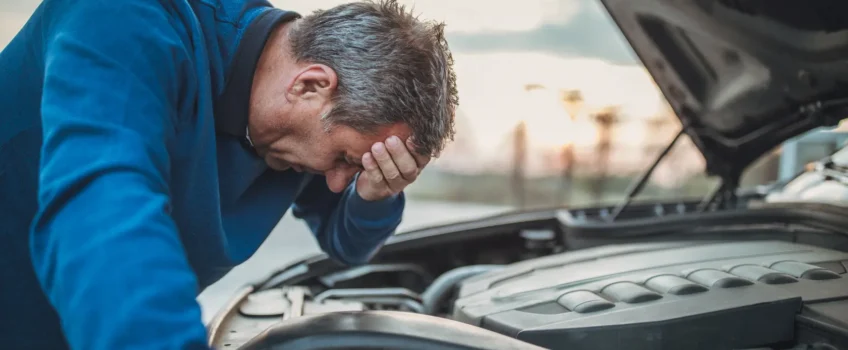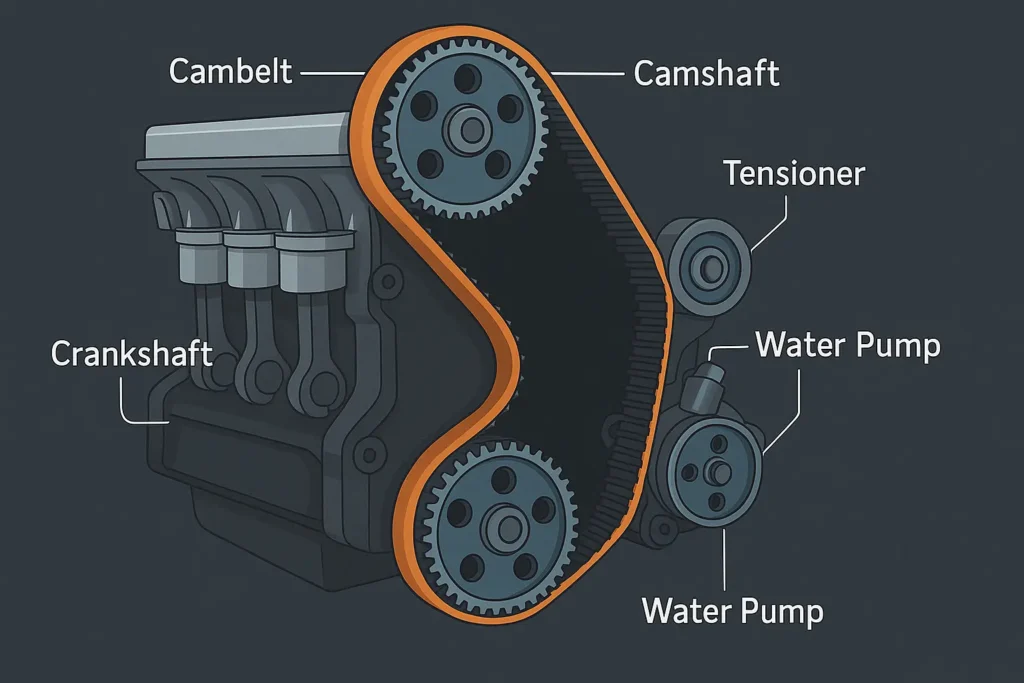
Is It Dangerous If a Cambelt Snaps While Driving?
When it comes to vehicle maintenance, few issues are as serious as a cambelt (timing belt) failure. But what happens if your cambelt snaps while driving? The short answer: you could be facing catastrophic engine damage and costly repairs. Let’s take a detailed look at what this means, how you can spot the warning signs of a faulty cambelt, and what to do if the worst happens.
What Is a Cambelt and Why Is It So Important?
The cambelt (also known as the timing belt) is a critical engine component that synchronises the rotation of the crankshaft and camshaft. This ensures the engine’s valves open and close at the right time during each cylinder’s intake and exhaust strokes. If this timing is disrupted, the internal parts of your engine can collide and cause irreparable damage. This is why regularly checking and replacing your cambelt is crucial to the longevity of your vehicle’s engine.
What Happens If Your Cambelt Snaps While Driving on the Motorway?
If your cambelt snaps while driving on the motorway, it can have serious and potentially dangerous consequences for you and your vehicle. These can include:
- Engine failure
- Bent or broken valves
- Damaged pistons
- Broken camshaft
- Cylinder head or block damage
- Loss of power
- Costly repairs
- Safety risks
In many cases, this can mean a complete engine rebuild or even replacement – both of which are expensive and time-consuming. More importantly, it can also pose a safety hazard for you and other drivers on the road.
The Immediate Signs of Cambelt Failure While Driving
- Sudden engine shutdown
- Unusual noise (a loud snap or slapping sound)
- Warning lights on the dashboard
- Difficulty restarting the engine
If you’re driving at high speed when the cambelt fails, the consequences can be even more dangerous, potentially leading to loss of power steering or control, which increases the risk of an accident.
How to Avoid Cambelt Snaps While Driving
The best way to avoid facing the question “what happens if your cambelt snaps while driving” is by staying on top of your vehicle’s servicing schedule. Cambelts typically need replacing every 5 to 7 years or 60,000 to 100,000 miles, depending on your vehicle make and model. Always refer to your vehicle’s handbook for exact guidance or contact your nearest Elite Garages for more expert advice and guidance.
Warning Signs Your Cambelt Might Be About to Snap
- Ticking or high-pitched noises from the engine
- Oil leaking from the front of the engine
- The engine struggles to turn over
- Visual signs of wear (if inspected by a mechanic)
What To Do If You Suspect Cambelt Failure
If you hear strange noises or your engine shuts off unexpectedly, don’t try to restart the vehicle. Pull over safely, turn off the ignition, and call for roadside assistance. Continuing to run or restart the engine could make the damage worse.
Once your vehicle is towed to a mechanic or car technician, they will be able to diagnose the problem and determine if it is indeed a snapped cambelt. If this is the case, the entire cambelt system will need to be replaced, as well as any other damaged components. This can be an expensive repair, but it is necessary to prevent further damage to your engine.
Cambelt Replacement Services at Elite Garages
Elite Garages offer expert cambelt inspection and replacement services at competitive prices. Our experienced technicians use OE-quality parts and follow manufacturer specifications, giving you peace of mind that your engine is protected.
When you book a cambelt replacement with us, you get:
- A full assessment of your vehicle’s timing system
- Top quality cambelt replacement parts
- Professional fitting and warranty coverage
Recommended: Why Your Cambelt Needs Replacing
Is There a Difference Between a Cambelt and a Timing Belt?
The short answer is no—”cambelt” and “timing belt” refer to the same component in your vehicle’s engine. These terms are often used interchangeably, though “timing belt” is more common in some regions, while “cambelt” tends to be used more frequently in the UK. Regardless of the name, both describe the same crucial part of the engine.
What Other Belts Are There in a Car?
While the cambelt (or timing belt) is one of the most critical belts in your engine, it’s not the only one under the bonnet. Most vehicles also rely on other belts to power essential systems. Here’s a breakdown of the most common ones:
1. Auxiliary Belt (Serpentine Belt)
Also called the drive belt or fan belt, this long, winding belt powers multiple components including the alternator, power steering pump, air conditioning compressor, and sometimes even the water pump.
- Function: Transfers power from the engine’s crankshaft to various accessories.
- Signs of wear: Squealing noises, cracks, or sudden failure of powered systems like AC or steering.
2. V-Belt (Older Vehicles)
In older models—especially pre-1990s—V-belts were used instead of a single serpentine belt. Each accessory had its own belt.
- Function: Similar to the auxiliary belt, but separate belts for each system.
- Signs of wear: Slippage, squealing, or component failure.
3. Timing Chain (Instead of a Cambelt)
Some vehicles use a timing chain instead of a belt. Made from metal, these chains often last longer, but they’re not immune to issues.
- Function: Just like a cambelt, it synchronises the crankshaft and camshaft to keep the engine running smoothly.
- Signs of issues: Rattling sounds, poor performance, engine misfires.
Why It Matters
If any of these belts fail, your car’s performance will suffer—if not stop altogether. But the most severe damage happens when a cambelt snaps while driving, which can lead to catastrophic engine failure, bent valves, and costly repairs. Unlike a worn auxiliary belt, a snapped cambelt won’t just leave you stranded—it can destroy your engine.
Other Vehicle Services Offered by Elite Garages
While cambelt replacement is one of our key services, Elite Garages also provides a wide range of vehicle maintenance options:
- MOTs
- Car servicing (Bronze, Silver and Gold)
- Tyre fitting
- Wheel alignment
- Air con regas and servicing
- Brake pads and brake disc replacement
- Battery replacements
- Diagnostic checks
- ADAS calibration at select Elite Garages locations
We operate multiple branches across the UK with friendly, knowledgeable staff ready to keep your vehicle safe and roadworthy. Here’s why customers choose Elite Garages for car services.
Final Thoughts on Cambelt Snaps While Driving
So, what happens if your cambelt snaps while driving? The reality is harsh – engine failure, expensive repairs, and serious safety concerns. But the good news is that it’s preventable. Regular servicing and timely cambelt replacement are your best defences. Trust Elite Garages to help you stay ahead of costly engine problems. Book your cambelt check today and drive with confidence.
FAQS: Cambelt Snaps While Driving
Click the + to read any answer or visit our most FAQ page to review the most frequently asked questions across all our Elite Locations.
If you click on a ‘Category’ or ‘Tag’ link, the page will ‘refresh’ and reload the page showing the top of the page first, you’ll then just need to scroll down to the FAQ section to see the results for the Category or Tag you selected.
A Class 4 MOT checks various components of your vehicle to ensure it meets the UK’s safety and environmental standards. The test includes an inspection of the brakes, lights, tyres, suspension, emissions, and more. If any of these components do not meet the legal requirements, your vehicle will fail the test, and you’ll need to have repairs done before re-testing. Ensuring these components are regularly maintained will help you pass the MOT without any issues.
Driving without a valid MOT is illegal in the UK. If caught, you could face a fine of up to £1,000. Additionally, if you’re involved in an accident, your insurance could be invalidated, and you may be liable for damages. The only exception is driving to a pre-booked MOT appointment. To avoid this risk, ensure you schedule your MOT before your MOT due date.
A Class 4 MOT covers standard vehicles like cars, taxis, and motorhomes with a gross vehicle weight (GVW) of up to 3,000 kg, making it the most common type of MOT test. A Class 7 MOT, on the other hand, is required for heavier commercial vehicles that weigh between 3,000 kg and 3,500 kg, such as large vans and trucks. Both classes check safety features, emissions, and roadworthiness, but Class 7 includes stricter weight-bearing component inspections due to the heavier loads carried by these vehicles.
You can find your MOT due date by checking the MOT certificate provided after your last test, or by using online tools like the government’s MOT check service. Vehicles over three years old must undergo an MOT test annually. It’s important to keep track of this date, as driving without a valid MOT is illegal unless you’re going to a pre-booked test. Many garages and online services offer MOT reminders to ensure you don’t miss your MOT due date. You can sign up for the Elite Members Club to receive your MOT and service Reminders!
About Us
Opening Times
Saturday : 8:30–4:00
Sunday : closed
More Information
Contact UsCustomer Information Pack
Check MOT Due Date
Free MOT reminder
Careers
Legal Information
Recent Posts
- MOT in Brighton: Your Essential Guide to Testing, Servicing and Tyre Safety
- Uneven Tyre Wear Explained: Is It Time for a Wheel Alignment Service?
- Is Your Track Rod End Causing Wheel Alignment or Suspension Problems?
- Brake Repairs in Bournemouth: Why Stop-Start Roads Are So Tough on Your Car
- MOT in Dorchester: Keeping the South Coast Safely on the Move



